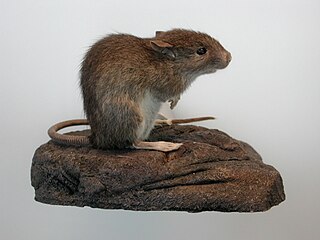The earless water rat is a New Guinea rodent, part of the Hydromys group of the subfamily of Old World rats and mice (Murinae). It is the only species of the genus Crossomys. This species is probably most closely related to Baiyankamys. It is still unclear to which species this group is related. It is one of the most aquatically adapted rodents of the world.

Leptomys is a genus of rodent endemic to New Guinea. It is considered part of the New Guinea Old Endemics, meaning it was part of the first wave of murine rodents to colonize the island.
Shaw Mayer's water rat is a semiaquatic species of rodent in the family Muridae. It is found in the mountains of Papua New Guinea.

The long-footed water rat is a species of rodent in the family Muridae. It is found in the mountains of southern Papua New Guinea. Its natural habitat is subtropical or tropical dry forest.
De Vis's woolly rat is a species of rodent in the family Muridae. It is found only in Papua New Guinea.
The subalpine woolly rat is a species of rodent in the family Muridae. It is found in West Papua, Indonesia and Papua New Guinea.
The large mosaic-tailed rat is a species of rodent in the family Muridae. It is found in West Papua, Indonesia and Papua New Guinea.
The long-nosed mosaic-tailed rat or Papuan lowland paramelomys is a species of rodent in the family Muridae. It is found only in Papua New Guinea.
The mountain mosaic-tailed rat is a species of rodent in the family Muridae. It is found in West Papua, Indonesia and Papua New Guinea.
Musser's shrew mouse is a species of rodent in the family Muridae. It is found only in Papua New Guinea. Its natural habitat is subtropical or tropical moist montane forests.

The northern water rat is an endangered species of rodent in the family Muridae found in the highlands of New Guinea.
The large tree mouse is a species of rodent in the family Muridae. It is found on the island of New Guinea.
The gray-bellied tree mouse is a species of rodent in the family Muridae. It is found only in Papua New Guinea.

The New Guinean rat is a species of rodent in the family Muridae. It is found only in parts of central Papua New Guinea.
The moss-forest rat is a species of rodent in the family Muridae. It is found in Indonesia and Papua New Guinea.
Van Deusen's rat is a species of rodent in the family Muridae. It is endemic to the mountains of southeast Papua New Guinea.
The slender rat is a species of rodent in the family Muridae. It is found in West Papua, Indonesia and Papua New Guinea.
The Bismarck giant rat is a species of rodent in the family Muridae. It is endemic to the island of New Britain, Papua New Guinea.
Leptomys paulus is a small rodent belonging to the family Muridae endemic to New Guinea.
Leptomys arfakensis is a species of rodent in the family of Muridae. It is found in the Arfak Mountains of West Papua, Indonesia.




